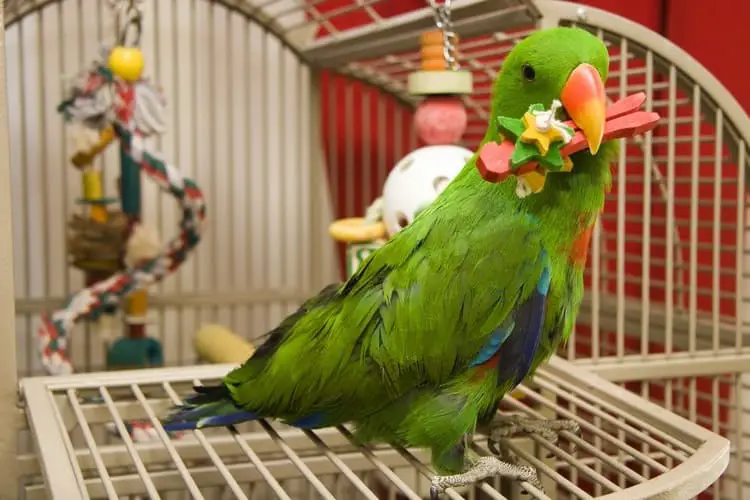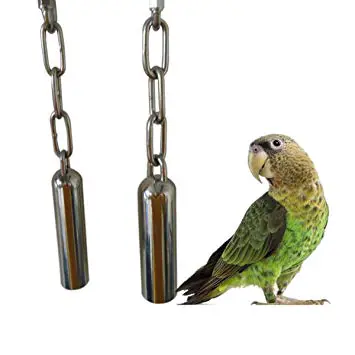Parrots are known for their colorful and friendly nature. They are also popular for their ability to turn everything over. Some are escapist, and some have a very determined nature that they would destroy everything on their paths.
Take the cockatoo, known as one of the most intelligent pet birds. This bird is also known for their destructive abilities, especially during springtime, where they can chew anything in their paths! If you have a pet cockatoo, then you must be conscious about this behavior and try to correct it at once. Also, you must learn about some of the dangerous materials which your pet may ingest. We are talking about unsafe metals that your pet may get sick from.
Parrots and metals don’t go well together
Wood is usually okay for parrots to chew and eat, but metals are a different story. Metals and parrots don’t go well together and a condition known as metal toxicity can happen when an animal ingests metals that contain zinc, copper or lead. Metal toxicity is a dangerous condition and, if not properly checked, can lead to very dangerous conditions and can even cost your pet its life.
What is heavy metal toxicity?
Heavy metal toxicity is common in birds when the animal ingests or chews on dangerous metals that contain copper, zinc, or lead. Birds like parrots may become interested in objects like pennies and those that have been minted before the year 1982 contain significant amounts of copper which are very toxic to birds. Also chewing on electrical wiring, which contains copper, can lead to heavy metal toxicity.
And if you think wood is safe, think again. Wood that has been painted with paint that contains lead may also affect your bird. If the bird chews on the wall of an old house or chews on an old cage with paint, then it can swallow bits of paint.
Once the metal is inside the bird’s body, anything that the animal does not pass in its feces will be stored inside its body. These small pieces will lie inside the digestive system and will continue to reek dangerous toxins inside the body. These dangerous bits of metal will slowly kill your pet
Symptoms of heavy metal toxicity in parrots

Heavy metal toxicity does not have specific symptoms, and usually, it is detected when the condition is already turning for the worse. Early symptoms of this condition are different from one bird to another, but the most common are
- Lethargy and depression – your pet will appear weak and lethargic. But although this symptom may also be due to other diseases or health conditions, weakness and lethargy are accompanied by depression. As a pet owner, you must know how to tell your pet is depressed or if it is happy. Depression in birds includes sitting or perched in one area, not socializing with other birds, and not following your commands or tricks.
- Reduced appetite – this is very noticeable since by now, you already know how much your pet can eat in a day. Pets who eat a scoop of food that suddenly can’t eat even a few bits may be sick or feeling unwell.
- Weight loss – weight loss is hard to see in birds, especially those with very prominent feathers, but in parrots, it can be seen from the cheeks. Healthy parrots have fluffy cheeks with well-formed eyes. Parrots that are suffering from weight loss may have sunken cheeks and bulging eyes. Also, if you keep a record of your pet’s weight, then you can weigh your pet as well. Some pet owners notice that their pet parrots develop loose feathers, especially along the neck and face when there are sick. Some birds even shed their feathers as a sign that they have massively lost weight.
- Increased fluid intake – it may be the body’s way of flushing the toxins out, and this is what happens to pet parrots suffering from metal toxicity. You will find your pet heading for its water dish time and again. It may refuse to eat, but it will simply drink to its heart content.
- Weird droppings (blood, greenish color, or loose stools) – stools with varying colors, especially bright green and gooey green, can be a sign of metal toxicity. Also, blood in the stool or urine can be a dangerous sign. This means that your pet’s digestive tract is already suffering a lot of damage from metal toxicity.
Loose stools are common signs of most illnesses, but in metal toxicity, loose stools can last for a long time, and this can lead to malnutrition and weight loss. - Vomiting – you can see your pet throwing up its food or any medication you have given. It will also throw up for no reason, possibly another way of the body to remove toxins.
- Weakness – You will see generalized weakness. Your pet won’t be as active as it was before. If your pet loves a certain activity like playing tricks, following commands, and simply flying from one area of the cage to another and all of a sudden, it does not do these anymore; then, it may be suffering from weakness.
Some pet owners also identify weakness as simply sitting in one corner of the perch doing nothing or even sleeping for longer periods. - Poor gait, falling from a perch – you can tell that your pet’s condition has turned for the worse when it has the poor gait, and it is unable to stay perched on its perch. You might see if falling off the perch or become unbalanced. This is a serious symptom and should never be overlooked.
- Seizures – fine trembling or uncontrollable movement of the face, neck, and limbs are seizures, and in parrots, with metal toxicity, this means that the metals are already wreaking havoc in your pet’s system. The toxins have dissipated in the brain and are causing these seizures.
Are there safe metals?

As much as there are dangerous metals, there are also safe metals that your pet may be exposed to. Take note that most things that we think are metals are usually composed of different alloys. Alloys are metals that are fused to create a stronger, corrosion-resistant metal. You need to identify the different metals used in every alloy.
Chromium
One of the most common alloys is chrome, which is chromium or “chrome-plated.” This is known as safe, but some chrome-plated items come with zinc, and there is no way for people to know if this is part of the metal. And because zinc may or may not be present in a chrome-plated material or object. You cannot rely on a notion that the object is probably safe or even 95% safe when it comes to the safety of your pet.
Stainless steel
Stainless steel is known as an alloy that is known to be safe to use, and this is despite stainless steel possibly having at least 10% chromium with steel. Because chromium may contain a small amount of zinc, and stainless steel items only have a tiny amount of chromium in very small levels, then this is safe.
Stainless steel is known to be a more-preferred metal in making birdcages and perches. Also, this metal can withstand even the strongest parrot beaks and is very easy to clean and maintain.
Nickel
Nickel-plated items are also known to be safe. Toys that are nickel-plated, dishes, and water containers with this material are also safe to use.
Steel and iron metals
Two of the safest metals are steel and iron; however, these metals will rust in water. And because you cannot do without water in a parrot’s cage, these two metals are not good metals to use as a parrot cage or parrot furniture. And aside from the parrot water dish, water can also come from cleaning the bird’s cage, which is unavoidable.
Aluminum
Another safe metal is aluminum because this will never rust like steel or iron. But this can corrode to aluminum oxide, which is a grayish-white material with a powdery texture. Compared to rust, aluminum oxide is non-toxic when this is ingested or when handled. Your pet bird will remain safe even when it chews on its cage made of aluminum.
Any non-galvanized metal
You can use any kind of metal as long as this is non-galvanized. Galvanizing is a process wherein a layer of zinc is added to metal to protect it from rust. When a metal is used outdoors like a metal roof, galvanization will add a protective coat of zinc to keep the metal roof safe from the sun and rain.
When it comes to buying metal toys and accessories for your pet parrot, consider items that are made from stainless steel or are nickel-plated to ensure the safety of your pet. If you need to replace a broken part like a door, screw, or handle, make sure to ask for a replacement that is made from safe metals. But if you are still unsure about the metal items and accessories that are sold in a local store, follow a simple rule that only stainless steel, aluminum, and nickel-plated metals are allowed.
Are there safe bird toys?

Now that you know which metals are safe and which ones are okay to be used on your pet bird, it’s time to learn other materials that can also harm your pet.
Yes, some metals are unsafe and can even cause the life of your pet, but some materials can be very dangerous to your pet parrot, and you may have never known from the start.
Painted bird toys
As mentioned, wooden bird furniture and toys are not as safe as you may think. First of all, the paint used on these pieces may contain lead and copper, and this can also be very toxic to your pet. Paint has varying amounts of these metals, and if you’re not careful, your pet can suffer from serious symptoms as it plays with these toys or uses furniture.
Aside from the pain, the glue that is used to hold wood and fabric pieces together may also reek with toxic chemicals. Also, paint and glue are applied on the surface of the toy don’t soak the toy compared to dyes. Thus, this settles on the surface of the toy and is easily eaten by your pet.
Also, colorful toys are very attractive to parrots. Once they get their hands on these painted objects, they can eat these and thus can be dislodged inside their digestive tracts leading to blockage. However, dyes are mostly vegetable-based and are thus very safe to use to make toys and furniture for pet parrots.
Leather bird toys
Regular leather products like belts, shoes, and clothing are made by tanning the hide to remove fats and other unwanted components in natural leather. But tanning uses dangerous acids that can remain in leather for a long time and ingest by your pet. So for your pet parrot, the leather used must be vegetable-tanned. In this process, the tannins in vegetable process leather without dangerous chemicals and thus are safe for your pet. Leather toys like balls, bags, cubes, and climbing ropes may be introduced to your pet’s cage and your pet can peck on it, eat it and digest it without any worries.
Metal hardware
Toys with metal components should be made from stainless steel or should be nickel-plated. The pieces must not be movable or digestible, so your pet won’t ingest the part and get sick. The toys must not have any weird shape, which can become stuck in the bill of your pet parrot. If the bill is stuck to wire or any part of the toy, you should take this to the vet at once.



